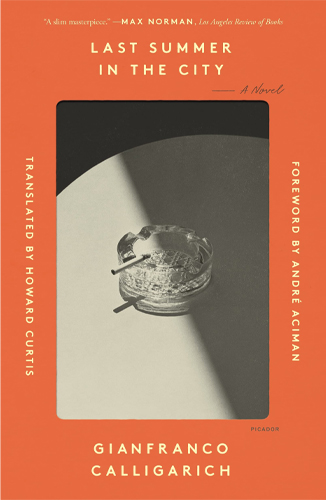When American readers think of literature’s great masterpieces, titles like The Great Gatsby and The Sun Also Rises come quickly to mind— foundational works that were both born of the English language and, then, shaped the language in their very image. However, thinking about literary greatness from a solely domestic lens keeps us from experiencing equally foundational works born out of other nations, such as Gianfranco Calligarich’s Last Summer in the City.
For decades, Calligarich’s seminal 1970 novel was accessible only to Italian Language speakers. However, in recent years it was translated into English by Howard Curtis and re-released in 2021 by Farrar, Straus and Giroux. The release of Calligarich’s novel into English over fifty years after its original print run can appear curious at first, leaving us wondering what this slim novel of the past has to show us about our present. Curiouser still, the answer is nothing.
The Last Summer in the City is anchored firmly in the specific place and time it originated in. It speaks to Rome and only Rome— the Rome that defined one man’s experience in one summer of his life, adrift in the late 20th century. It speaks to a sweltering Rome, a Rome that gets under your skin, into the dark corners of your mind, pushes you away, and beckons you back just as quickly. It is Rome as our protagonist Leo Gazzara knows and understands it: indifferent and cruel, and seductive all the same.
And yet even though it is Leo’s Rome and only Leo’s Rome we are being transported to, the city comes alive for us in Calligarich’s prose in a way that temporarily suspends logic and makes us believe that we are not simply reading fiction and instead experiencing a potential past life, walking these streets and feeling Leo’s wrenching emotions for ourselves. As Calligarich writes of Rome, “There can be no half measures with her, either she’s the love of your life or you have to leave her.”
That is the truth that Leo wrestles with in the span of these pages as he’s stuck in limbo between these two polarities. As readers, we are privy to every decision and indecision that keeps him stuck in this aimless, drifter state. And though we may be able to see solutions that Leo cannot, we begin to see Leo’s trajectory as inevitable– to Calligarich’s credit as a craftsman.
Of course, what makes Calligarich’s novel such a masterpiece– worthy of commanding readers’ attention across generations and nations— is that he makes the profound isolation of being an individual in a mammoth city such as Rome accessible to whoever decides to pick up these pages. One does not simply read Last Summer in the City. One descends into it, despite all of the risks, pains, and losses that Calligarich’s Rome promises. In that way, we ourselves become Leo, trying to decide if we should love or leave.
Natalli Marie Amato
Natalli Amato is a music and lifestyle journalist from Sackets Harbor, New York. Her bylines include Rolling Stone, Vice, and The Boot. She is also the author of several collections of poetry.


